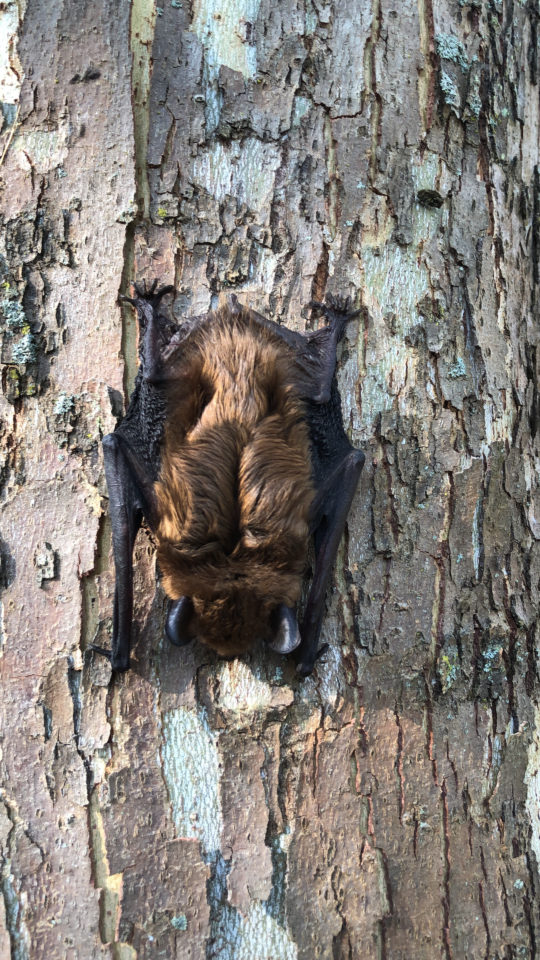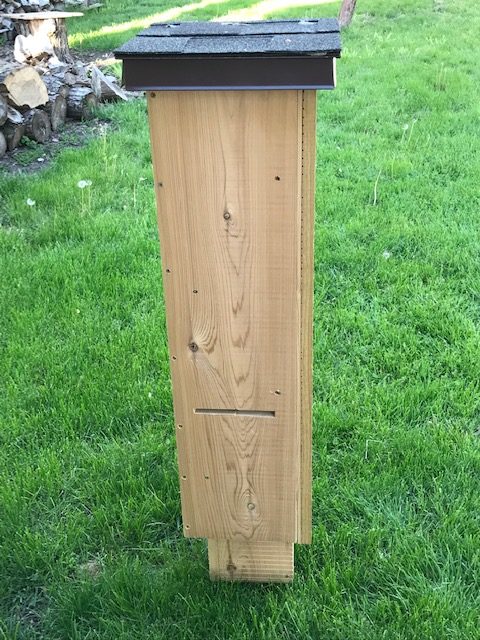Night flying bats are the only mammals that truly fly. Bat species that live in groups are called colony bats. Camp Friedenswald has added an additional bat house, this time a rocket style house constructed and donated by former camp staff Penny Yarman. The house is four feet tall with two chambers in each of the four sides and will eventually be a daytime roosting site for hundreds of bats.

In Michigan, common colony species that are seen by humans are big brown bats (Eptesicus fuscus) and little brown bats (Myotus lucifugus.) Bats migrate when the flying insect population decreases, going north to abandoned mines to hibernate during the cold months. Upon their return migration bats give birth May through June, with both common species producing one young, called a bat pup. Young bats grow quickly and are able to fly within three weeks. The placement of the bat house at the upper end of the lower/Cottonwood (chapel) flat is positioned to catch the first rays of the morning sun. The sun warms the box increasing the chances of bat pup survival, since they are born naked.
While initial occupants of the house will likely be bachelor bats forced out in June and July by overcrowded conditions, eventually the house will be a maternity colony as well. Currently there are bats roosting inside the soffit areas on the opposite gable end of Cottonwood Center. When they get crowded there, we should see occupancy in the rocket bat house. So while we may not have occupancy next spring, bats foraging for insects with their echolocation system (in addition to their sight) will recognize hollow sounds coming back to them from the rocket bat house and identify it as a potential roosting site.
Bats are insectivores with large appetites, can consume one half or more of their body weight in insects in one night. Some mosquitoes are part of a bats diet, however they prey on/eat many other insects, for example, the moths that lay eggs on vegetables and fruits.

Occupancy will be ascertained by bat guano (excrement) on the ground at the base of the twenty foot pole (donated by Keith Sommer.) And it will be confirmed as camp visitors at dusk will see bats dropping from the bat house and swooping up and into the air as they begin to forage for flying insects nearby, then head to the fen where insect populations are more numerous. At daybreak early risers will see bats returning, going into a holding pattern, circling, and swooping up to the landing boards below the bat box.
Bats are not to be feared. They will avoid coming into contact with you, although they may eat insects in the air near you attracted to your body/hair odors or because your blood is needed for insect reproduction cycle, yes mosquitoes. It is not advisable to touch a bat at rest without a heavy leather glove for, like cats and dogs, they can be carriers of rabies. If a bat is inside your house, open a window and/or door and turn off the lights, for the bat will find the opening at leave.

White nose syndrome is a mysterious disease that has killed many bats in recent times during their hibernation period. Even so, bats have been seen flying in the open areas of camp this summer. And bat guano has been seen at camp in several places. Jonathan Fridley, Phil Nyce, Jack DeLee, and Titus King erected this bat house in late September. ‘Build the bat house, and they will come.’ Believe it. Check it out. Support nature in all its wonder and beauty and diversity. And shout out if you see bats emerging from or returning to the rocket bat house on the Lower Flat.